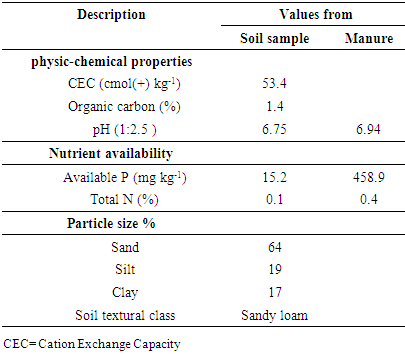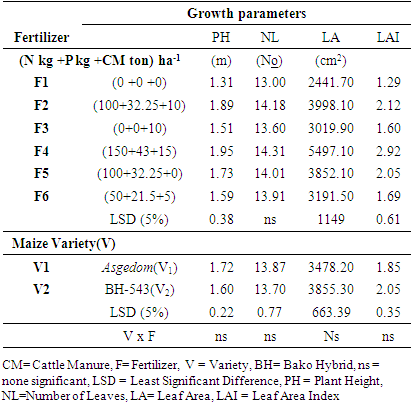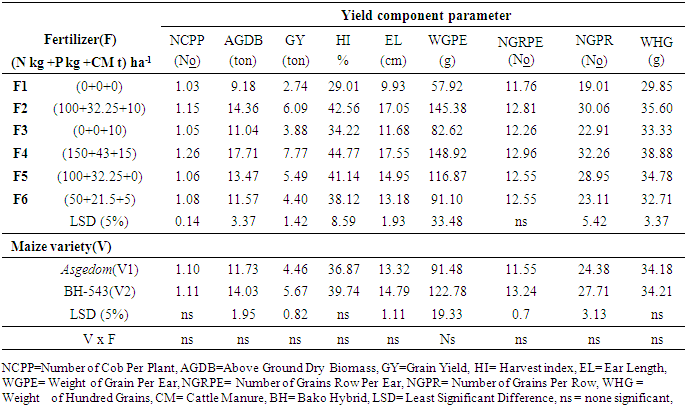-
Paper Information
- Previous Paper
- Paper Submission
-
Journal Information
- About This Journal
- Editorial Board
- Current Issue
- Archive
- Author Guidelines
- Contact Us
International Journal of Agriculture and Forestry
p-ISSN: 2165-882X e-ISSN: 2165-8846
2020; 10(3): 71-75
doi:10.5923/j.ijaf.20201003.02

Effects of Organic and Inorganic Fertilizers on the Growth, Yield and Yield Components of Maize Varieties
Berhe Germay1, Andargachew Gedebo2
1Shire Agriculture Technical and Vacation Education & Training College, Shire, Ethiopia
2School of Plant and Horticultural Sciences, College of Agriculture, Hawassa University, Ethiopia
Correspondence to: Andargachew Gedebo, School of Plant and Horticultural Sciences, College of Agriculture, Hawassa University, Ethiopia.
| Email: |  |
Copyright © 2020 The Author(s). Published by Scientific & Academic Publishing.
This work is licensed under the Creative Commons Attribution International License (CC BY).
http://creativecommons.org/licenses/by/4.0/

Maize is one of Ethiopia’s major and strategic cereal crops, albeit the national average yield remains low. The study was conducted at Adi-gebaro farmers association of Tigray region in Ethiopia, from December 2016 to May 2017, to determine the combined effects of organic and inorganic fertilizers on growth, yield and yield components of maize varieties under irrigation. The experiment was factorial with six rates of combined fertilizers [F1 (0+0+0) ha-1, F2 (100 kg N +32.25 kg P +10 t cattle manure) ha-1, F3 (0+0+10 t cattle manure) ha-1, F4 (150 kg N +43 kg P +15 t cattle manure) ha-1, F5 (100 kg N +32.25 kg P + 0) ha-1, F6 (50 kg N +21.5 kg P +5 t cattle manure) ha-1] and two varieties of maize (BH-543 and “Asgedom”/local). The design was Randomized Complete Block with three replications. The interaction effect between varieties and fertilizer rates was not significant. However, the differences between varieties and among fertilizer rates were significant (P<0.05) for growth, yield and yield component parameters. The highest grain yield 7.77t ha-1 was recorded with fertilizer rate of F4 followed by F2 and F5. Variety BH-543 exceeded the local variety by 1.21 t ha-1 or 21.34% in grain yield. It can be concluded that using combined fertilizer rate of F4 (150 kg N +43 kg P +15 t cattle manure) ha-1 and maize variety of BH-543 would be suitable for growing maize under irrigation at agro ecological conditions of Adi-gebaro.
Keywords: Combined fertilizer rate, Inorganic, Organic, Maize, Yield
Cite this paper: Berhe Germay, Andargachew Gedebo, Effects of Organic and Inorganic Fertilizers on the Growth, Yield and Yield Components of Maize Varieties, International Journal of Agriculture and Forestry, Vol. 10 No. 3, 2020, pp. 71-75. doi: 10.5923/j.ijaf.20201003.02.
Article Outline
1. Introduction
- Maize (Zea mays L.) is among the major cereal crops of Ethiopia, having important role in the country's food security and farmers' livelihood [1]. It is the cheapest source of calories among major cereals [2]. Despite its importance, the national average grain yield of maize remains as low as 2.3 tons ha-1. This low yield is attributed to the use of low yielding varieties with improper crop management especially of fertilizers. Sustainable crop production system can be achieved through replenishing nutrients removed by the crop from the soil and maintaining physical conditions of the soil [3]. Thus, adoption of appropriate soil fertility and nutrient management practices may help farmers to enhance crop production and conserve natural resources and this can be accomplished through application of mineral and organic fertilizers [4].Mineral fertilizers have been important input to get higher crop productivity. However, over reliance on mineral fertilizers is related with decline in some important soil properties and crop yields over time. On the other hand, use of organic fertilizers regularly lead to increased soil organic matter, water holding capacity, improved soil structure, and nutrient cycling; and helps to keep soil nutrient status, cation exchange capacity and soil’s biological activity. Therefore, combined use of mineral and organic fertilizers is a viable approach for efficient nutrient usage which improves efficiency of the mineral fertilizers while reducing nutrient losses [4].The fluctuations in the onset and distribution of the rain, in the resent years have been forcing the farmers to use irrigation for growing maize, especially in the northern part of the country. Under these conditions it is necessary to identify suitable maize variety and the appropriate combination of organic and inorganic fertilizers. Therefore, the current study was conducted to investigate the combined effects of organic and inorganic fertilizers on the growth, yield and yield components of maize varieties.
2. Materials and Methods
2.1. Description of the Study Area
- The experiment was conducted in Adi-gebaro farmer association located at 14°07’ N and 38°10’ E, 1,616 m.a.s.l., in Tahtay Koraro district, north western zone of Tigray regional state, Ethiopia. The mean annual precipitation, minimum and maximum temperatures of the area are 1053.3 mm, 14.4°C and 27.5°C respectively. The experiment was conducted during the dry season from December 2016 to May 2017, under irrigation.
2.2. Treatments, Design and Management
- The experiment was factorial with two maize varieties, (“Asgedom “ local and BH-543 improved) and six fertilizer (F) rates: F1 (control with no fertilizer), F2 (100 kg N ha-1 +32.25 kg P ha-1 +10 t cattle manure ha-1), F3 (10 t cattle manure ha-1), F4 (150 kg N ha-1 +43 kg P ha-1 +15 t cattle manure ha-1), F5 (100 kg N ha-1 +32.25 kg P ha-1) and F6 (50 kg N ha-1 +21.5 kg P ha-1 +5 t cattle manure ha-1). The design was RCBD with three replications. The spacing between blocks and between plots was 1.5 and 1m respectively. The size of each plot was 3 m x 4.5 m (13.5 m2). Each plot consisted of six rows. The seed was sown with 0.25 and 0.75 m between plants within a row and between rows respectively. Nitrogen was applied in three splits: the first at the time of sowing along with a full dose of P, the second at 15 days from sowing and the last at the tasseling stage. Furrow irrigation method was used to irrigate the crop. Hand weeding was done three times during the crop growth period. The agronomic practices were applied to all treatments uniformly.
2.3. Data Collected
- Plant height (m) was measured after anthesis from the soil surface to the top of the tassel. The mean height of ten plants per plot was recorded. Leaf number was determined by taking the mean from the count of leaves from ten plants per plot. Leaf area (LA) was calculated as LA = K*LL*LW, where LL was the length of the leaf from the junction of the leaf blade to the leaf tip, LW the width at the widest part of the leaf and K constant with value of 0.75 [5]. The leaf area index was calculated as the ratio of leaf area to ground area, where leaf area was measured from five plants per plot and ground area as the area of the ground under the canopy of these five plants. The average number of cobs per plant was recorded by counting the cobs from ten plants per plot randomly. Above ground dry biomass was determined from the above-ground parts of the plant after harvesting from an area of 3 m2 of the plot and converted to tons ha-1. Grain yield was recorded as the grain weight of plants from 3 m2 plot area, adjusted to 12.5% moisture content and converted to ton ha-1. Harvest index was determined as the ratio of dried economic yield to dried biological yield [6]. Ear length was determined as average ear length of ears from ten plants. The number of row per ear was considered as the average number of rows per ear from ten plants. The number of grains per row was determined as the average number of grains from rows of ears of five plants per plot. The weight of grains per ear was determined as the average weight of grains per ear from ears of ten plants. Hundred grains weight was determined as the average weight of 100 grains from a composite of seeds of ten plants.
2.4. Soil Sample and Manure Analysis
- Soil samples were collected at the depth of 0-40cm in a diagonal pattern within the experimental site using auger before treatment application. The collected samples were air dried, mixed and ground to pass through 2 mm sieve to remove large particles, debris, and stones. The samples were composited to one sample and 2 kg working samples were obtained from the composite sample. The samples were analyzed for pH, organic carbon, total nitrogen, available phosphorus, CEC, and soil texture. The pH of the soil was measured from soil to water ratio of 1:2.5 using pH meter [7]. Organic carbon was determined using wet oxidation procedure. Total nitrogen was analysed by wet oxidation procedure of Kjeldahl method [8]. Available phosphorus was analysed using Olsen procedure [9]. Cation exchange capacity (CEC) was analyzed using NH4 acetate method (FAO, 2008). Particle size distribution was analyzed using hydrometer procedure (Bouyoucos, 1962). Cattle manure was obtained from Shire Agricultural Technical and Vocational Education and Training College Dairy farm. The cattle manure was analyzed for N and P content using wet oxidation procedures of Kjeldahl (Bremner and Mulvaney, 1982) and Olsen (Olsen, 1954) respectively. The decomposed cattle manure was applied and incorporated into the soil of the respective plots one month before sowing.
2.5. Data Analysis
- Analysis of variance was done for entire data on maize traits using SAS software, GLM procedure version 9.0 [10]. Means were declared significant at 5% significance level using LSD.
3. Results and Discussion
3.1. Physico-chemical Properties of the Soil and the Cattle Manure
- The particle size distribution of pre-planting soil analysis of the experimental soil was 64% sand, 19% silt, and 17% clay with sandy loam texture (Table 1). As [11] reported, maize is best adapted in well-drained sandy loam to silt loam soil. The pH of the soil was 6.75 (slightly acidic), according to [12] the pH levels of soil for maize growth should be between 5.8 and 6.8, Therefore, the texture and pH of soil is suitable for maize production. The result indicated that the soil contained 0.1%, and 15.2 mg kg-1 of total nitrogen and phosphorus respectively. Soils having total nitrogen content >1.0% are classified as very high, 0.5-1.0% high, 0.2-0.5% medium, 0.1-0.2% low and less than 0.1% very low [13]. Available phosphorus content of the soil > 25, 18-25, 10-17, 5-9, and less than 5 mg kg-1 are classified as very high, high, medium, low and very low respectively [9]. The results indicated that the availability of nitrogen was low, whereas that of phosphorus was medium. The soil analysis results showed that the experimental site is nitrogen deficient. Nitrogen application to the experimental soil was important to enhance the productivity of maize. The soil of the experimental site had cation exchange capacity of 53.4 cmol kg-1. According to the [13] CEC <6, 6-12, 12-25, 25-40, and greater than 40 cmol (+) kg-1 are grouped as very low, low, moderate, high and very high respectively. This indicated that the CEC of the soil was very high. The soil also had organic carbon content of 1.4%, Maria and Yost [14] rated organic carbon content <1.5, 1.5-2.5 and > 2.5% as low, medium and high respectively. This indicated that the organic carbon of the soil was low. The chemical composition of the cattle manure used for the experiment had nitrogen and phosphorus 0.4% and 485.9 mg kg-1 respectively Table 1).
|
3.2. Growth Parameters
- The interaction of fertilizer rate with maize varieties was not significant on growth parameters. The difference between varieties in growth parameters was also not significant (Table 2). However, the difference among fertilizer rates were significant (p<0.05) on growth parameters excluding leaf number, showing that the difference was caused by fertilizer effect rather than genetic. The highest plant height (1.95 m), leaf area (5497 cm2), and leaf area index (2.92) were obtained from the combined fertilizer rate F4 (150 kg N +43 kg P +15 t cattle manure) ha-1 (Table 2). It was followed by combined fertilizer rate F2 (100 kg N +32.25 kg P +10 t cattle manure) ha-1. This result is related to the finding of Ahmad et al. [15], who reported maximum plant height using in NPK (150-120-60) and recommended this dose along with poultry manure. The lowest value of growth parameters 1.31 m, 2441.7 cm2, and 1.29 for plant height, leaf area, and leaf area index respectively were obtained from the control or no fertilizer treatment (Table 2). With the increase in fertilizer rate from control (0) to combined fertilizer rate F4 (150 kg N +43 kg P +15 t cattle manure) ha-1 growth parameters: plant height, leaf area, and leaf area index were increased by 32.82, 55.65, and 55.82% respectively as compared to the control (Table 2). Similar results were reported earlier [16]. The increase in maize growth with the increase in combined fertilizer rate might have resulted from the readily available nutrients: nitrogen and phosphorus from inorganic fertilizers and the timely release of the nutrients from cattle manure, which enhanced cell multiplication and enlargement. The result is in line with the findings of Ahmad et al. [15].
|
3.3. Yield and Yield Components
- There was no significant interaction effect of fertilizer rates and varieties on parameters of yield and yield components. However, the difference between varieties and among fertilizer rates was significant. The improved variety BH-543 resulted in significantly higher (P<0.05) above-ground dry biomass, grain yield, ear length, weight of grain per ear, number of grain rows per ear, number of grains per row, number of grains per ear, and weight of ear than the “Asgedom” (Table 3). The difference might be due to the genetic potential difference between the varieties. Similarly [17] reported the effect of genetic potential on grain yield of maize. However the two varieties did not significantly differ in a number of cobs per plant, harvest index and weight of hundred grains (Table 3). Fertilizer treatments resulted in a significant difference (P<0.05) in all parameters of yield and yield components, except the number of grain rows per ear. The number of grain rows per ear is determined strongly by plant genetics and less so by environment. This means that row number for any given variety will be quite similar from year to year, irrespective of growing conditions. Particular exceptions to this comprise the effects of damage from the post-emergence application of certain sulfonylurea herbicides or nearly complete defoliation by hail damage prior to growth stage V8 [18]. The highest values of yield and yield component parameters were obtained on the fertilizer rate F4 (150 kg N +43 kg P +15 t cattle manure) ha-1, followed by F2 (100 kg N +32.25 kg P +10 t cattle manure) ha-1, F5 (100kg N +32.25 kg P) ha-1, F6 (50 kg N +21.5 kg P +5 t cattle manure) ha-1, F3 (0+0+10 t cattle manure) ha-1 and F1 (control ) in that order. The result showed increments in yield and yield parameters with the increase in combined fertilizer rate. The crop performance with the highest level of organic (cattle manure) fertilizer alone was superior only to those with control (Table 3).
|
4. Conclusions
- In this study local variety “Asgedom” was significantly earlier in phenological parameters than BH-543, whereas, in growth and yield component parameters BH-543 variety was significantly higher than “Asgedom”. The highest values in growth and yield component parameters were obtained from the combined fertilizer application F4 (150 kg N +43 kg P +15 t cattle manure) ha-1. The crop performance with the highest rate of organic fertilizer alone was superior to only those with control. Generally, from this finding the application of F4 (150 kg N +43 kg P +15 t cattle manure) ha-1 with Bako hybrid (BH-543) variety was recommended to boost grain yield under irrigation conditions at Adi-gebaro area.
ACKNOWLEDGEMENTS
- This work was financed by Shire Agricultural TVET College of Federal Democratic Republic of Ethiopia.
 Abstract
Abstract Reference
Reference Full-Text PDF
Full-Text PDF Full-text HTML
Full-text HTML

